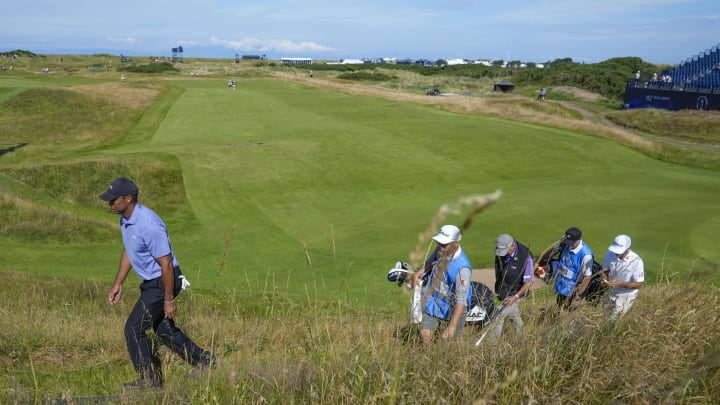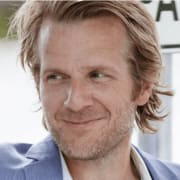SiriusXM's Taylor Zarzour on Calling the British Open, A Major Unlike Any Other

The British Open will get underway in the wee hours of Thursday morning here in the United States. SiriusXM PGA Tour Radio will deliver 45 hours of on-course coverage from Royal Troon in Scotland. Listeners will hear The Open Radio broadcast, produced by The R&A, on Thursday and Friday, and in the morning hours on Saturday and Sunday. SiriusXM’s produced play-by-play broadcast will take over and air on Saturday and Sunday afternoon. The Open Radio team will feature Marcus Buckland, Sue Thearle, Ron Jones, Matt Adams, Sophie Walker, Raymond Burns, Alison Walker, Paul Eales and Harry Ewing.
SiriusXM’s voices at Royal Troon will be Taylor Zarzour, tour pro Brendan De Jonge and Fred Albers.
Zarzour, who will provide play-by-play and run point for the other reporters, spoke to Sports Illustrated about one of golf's truly unique weekends.
Sports Illustrated: We spoke around this time last year for a longer piece about SiriusXM PGA Tour Radio and how valuable it is for someone on the go during golf. Curious if there's development that you're most proud of that's happened since then.
Taylor Zarzour: I would say that despite all the friction that we've had in the game of golf, the lack of unification that we have, how divided the game currently is with the PGA Tour and with LIV, that I'm most proud of the fact that our audience on SiriusXM PGA Tour Radio has continued to grow. Our volume of audience and the amount of people who are listening to us during major championships and during our biggest events has increased. Certainly the amount of respect and support that we've gotten from all of the governing bodies in the game and from the managers of the best players—and from the best players—has increased. When we used to show up at these major championships 5-10 years ago, it wasn't like the governing bodies were being disrespectful to us in any way, shape or form, but they weren't giving us exclusive interviews with Tiger Woods and all those guys. Now we show up at these events and they say who do you want and we get them. Because of that, I'm really proud.
SI: The Open Championship is obviously different than the other three majors. How is it different covering the most venerable one when a vast majority of players are outside of their comfort zone and on foreign soil?
TZ: It's definitely the most unique one. The food is different. The daylight is different. The weather is different. The ground is different. Everything feels a lot older and it feels obviously very European compared to what we experience in the States. If we were tennis or soccer or open-wheel racing then you wouldn't say that because they travel the entire world playing their series. But like you're saying, the other biggest tournaments in golf are all in the United States. Because of that, this feels very unique where it's light until 11 o'clock and it's light at 4:30 in the morning. The food is so different. I'm not saying better or worse but if you're a routine-oriented person, like most of these people are, then you have to go to great lengths to get the exact same diet that you have preparing. Almost all the top players in the game have nutritionists and private chefs that come in and cook for them so they have to go to greater lengths to get their exact diet to compete at the top level.
And then the biggest challenge is the land. You have a lot more room typically to land the shot off of the tee and a lot more room to land the shot when you're approaching the green but if you hit a big miss you could be in what they call a gorse bush and not find your golf ball. If you find it, chances are you can play it again a lot easier than you could in the States. You put all of that together and it's one of the most unique tests they have on the year. I think maybe 90 percent of the best players in the world live in the U.S. and it's a big transition to come over here and get comfortable with that.
SI: The setting is starkly different and for television audiences the visuals paint the picture. How do you bring the sense that this is a totally different style of golf on totally different Earth? How do you do something like that economically with your words?
TZ: When you come to Scotland you try to paint the picture of this is where this game was created and more than 400 years ago the game was started in this country by these people. It has been a part of who they are and is still a very large part of who they are as we sit here today. It's not that golf is not a big part of who we are in the States but it is definitely way more mainstream in Scotland than it is in the U.S. The people who play the game and follow the game anywhere else in the world are deeply connected and addicted to the sport but if you're not, you're not. And here it's a different story. Everyone is so much more familiar with the game. Every house on every street knows something about the game of golf because of how big of a focus there's been with the sport throughout this country's life. I'll try to describe that. In my mind it has a Fenway Park/Wrigley Field/Rose Bowl type association with the game, meaning if you think baseball you think Fenway or Wrigley. If you think basketball, you think Madison Square Garden. If you think the home of golf, you think the Old Course at St. Andrews and/or you think about Scottish links golf. I'm glad you asked that because when we're getting on on-air Sunday on SiriusXM I will certainly try to make that clear.
SI: The Open is also the last chance players have to capture a major until the next spring. Do you notice anything different in their mindsets or approaches when you speak to them with that as the backdrop?
TZ: The best players in the world—especially in the last 10 years or so—have thought about winning major championships, they've thought about winning a gold medal, and they've thought about winning the FedEx Playoffs. Probably in that order. At the beginning of the year there's all this hope because there's four chances. By the time you get to this one and it's the last chance, yeah, there's a little different mindset, especially if you haven't achieved all the things that you wanted. Certainly a guy like Rory McIlroy, in the last 10 years since he's won a major, puts more pressure on himself in this because it's the last one of the year and he has to wait nine months before he plays in another major championship. And he's trying really hard to reprogram his brain to not feel that added pressure. There's probably a little bit more level of desperation and pressure here than there are in the others because it's the last one.
And then when it comes to strategy, it requires such a different strategy. You have to use the ground here so much more than you would typically in the other majors. You have to think about how far your golf ball is going to fly and in some cases you have to guard against that. A guy like Bryson DeChambeau, who's known to be this prolific driver of the golf ball and can hit it these absurd yardages, he can't necessarily do that on most of the holes here. Then he has to think about, Okay, am I hitting 5-iron off this tee? Am I hitting hybrid off this tee? Where is it going to land and then where is it going to finish? This past Sunday is a great example of that. Robert MacIntyre from Scotland just won the Scottish Open and on No. 16 he hit a 7-iron from 250 yards. The ball landed 50 yards from the green and rolled all the way up there close to the hole. You have to figure all that in—where it's going to land and where's it going to finish. You almost never do that. They'll go back and play in this tournament in Minnesota next week on the PGA Tour and then a few weeks after that in Greensboro and after that in Memphis and they'll never make that decision in any of those tournaments. Here they have to make that decision on every single hole.
SI: That point you made about the extended runouts and how long the ball is on the ground there, and all the possibilities good and bad that such a style brings into play, is interesting because I'd have to imagine it requires a broadcaster to have a little more patience in relaying the quality of a shot.
TZ: Yes. It absolutely does and if you're not experienced playing in these conditions and playing this style of course, you can get a little more frustrated because you're not used to a bad break. You know, you can hit a ball down the middle of the fairway here and, like you're saying, 30 seconds later it ended up in some pot bunker and you have to hit out sideways. And you're like, That's not fair! I hit the right shot, that's not fair. Well, there's things that aren't fair that are going to happen in this event. There's also going to be great breaks that you get that you probably didn't deserve. There's probably a little more luck involved in this one than the other major championships but like you're saying, you have to program your mind to prepare for that in this event. I think traditionally you see the guys who are most creative and have the most patience win.
SiriusXM’s The Open Radio channel is available to listeners in their cars on channel 92 and on the SiriusXM app.
